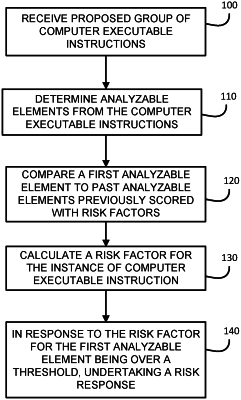| CPC G06F 11/3644 (2013.01) [G06F 11/3688 (2013.01); G06N 20/00 (2019.01)] | 20 Claims |

|
1. A method of analyzing computer executable instructions for risk comprising:
receiving computer executable instructions, wherein the computer executable instructions are yet to be executed;
determining a proposed risk factor for the computer executable instructions, wherein the determining the proposed risk factor comprises:
determining code level analyzable elements from the computer executable instructions, wherein the determining comprises reviewing a coding style of the computer executable instructions based on one or more of the following: comments in the computer executable instructions, libraries used by the computer executable instructions, indentation lines of codes of the computer executable instructions, uses of sub-routines of the computer executable instructions, existence of commands in the computer executable instructions, and lack of commands in the computer executable instructions;
recursively separating recognizable sections of the code level analyzable elements from unrecognizable sections;
executing a comparison of a first analyzable element to past analyzable elements stored in the memory that were previously deemed as one of the following: a known malicious code or a failure to align with a known good code, wherein the comparison compares the coding style to coding styles stored in the memory;
based on the comparison, calculating a coding style similarity score as part of the proposed risk factor with a deep learning algorithm, wherein the deep learning algorithm comprises checking the coding style similarity score against a score associated with one or more of the past analyzable elements stored in the memory;
determining a threshold for the proposed risk factor according to at least one of the following: a government authority with grades of thresholds, and a past history of the proposed risk factor of the computer executable instructions; and
in response to the determined risk factor calculated for the first analyzable element being meeting the determined threshold, undertaking a risk response, wherein the risk response comprises one of the following:
communicating a risk warning associated with the computer executable instructions, replacing the computer executable instructions identified as risk with a comparable computer executable instructions that have been determined to have an acceptable risk, or placing a hold on the computer executable instructions.
|